AUDI TT ROADSTER 2014 Owners Manual
Manufacturer: AUDI, Model Year: 2014, Model line: TT ROADSTER, Model: AUDI TT ROADSTER 2014Pages: 244, PDF Size: 60.87 MB
Page 201 of 244
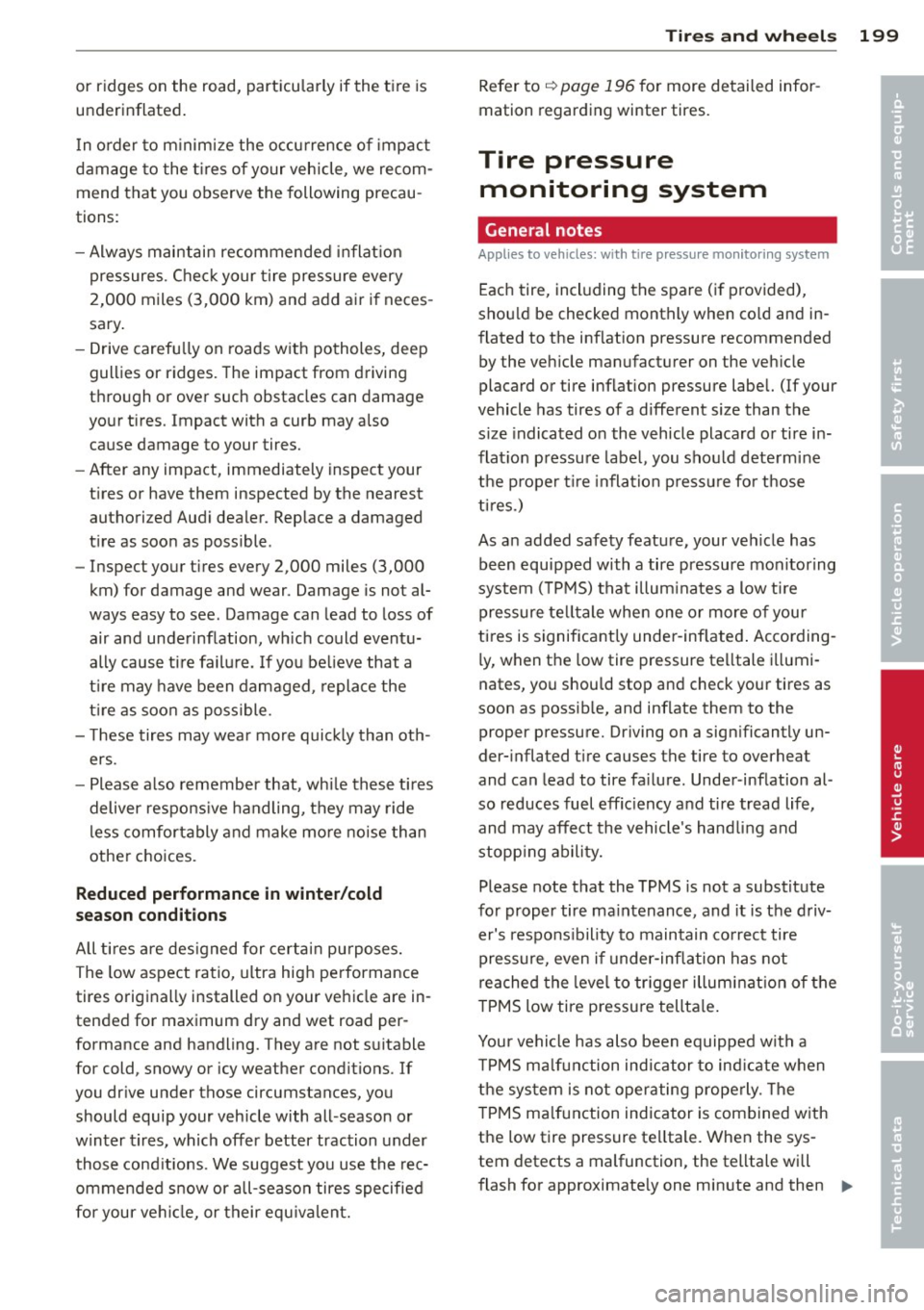
or ridges on the road, particularly if the tire is underinflated .
I n o rder to m inim ize the occu rrence of impact
damage to the t ires of your vehicle, we recom
mend that you observe the following precau
tions :
- Always maintain recommended inflat ion
pressures. Chec k your tire pressure every
2,000 miles (3 ,000
km) and add air if neces
sary.
- Drive carefu lly on roads with potholes, deep
gullies or ridges. The impact from driving
through or over such obstacles can damage
your tires. Impact with a curb may a lso
cause damage to your tires.
- After any impact, immediately inspect your
tires or have them inspected by the nearest
authorized Aud i dealer. Replace a damaged
t ire as soon as possible .
- Inspect your t ires every 2,000 miles (3,000
km) for damage and wear . Damage is not al
ways easy to see. Damage can lead to loss of
air and underinflation, wh ich could eventu
ally cause tire failure . If you be lieve that a
t ire may have been damaged , replace the
t ire as soon as possible.
- T hese tires may wea r mo re qui ckly than ot h
ers.
- Please a lso remember that, whi le these tires
deliver respons ive handling, they may ride
l ess comfortably and make mo re noise than
othe r choices.
Reduced perf ormance in winter /cold
s eason condition s
All tires are des igned for certa in pu rposes.
The low aspect ratio, ultra high performance
tires originally installed on your veh icle are in
tended for maximum dry and wet road per
formance and handling . They are not suitable
for cold , snowy or icy weather condit ions .
If
you dr ive under those circums tances, you
should equip your vehicle with all -season or
winter tires, which offer better traction under
those cond itions . We suggest you use the rec
ommended snow or all-season tires specified
for your ve hicle, or their equ ivalent.
Tire s an d wheel s 199
Refer to q page 196 for more detailed infor
mation regarding winter tires.
Tire pressure monitoring system
General notes
Applies to veh icles: w ith t ire pressure monitoring system
Each tire, incl uding the spare (i f provided),
shou ld be checked monthly when co ld and in
flated to the inf lation pressure recommended
by the veh icle manufacturer on the veh icle
placard or tire inflation pressure label. (If your
vehicle ha s tires of a different size than the
s ize indicated on the vehicle placard or tire i n
flat ion pressu re labe l, you shou ld dete rm ine
the p roper t ire inflation p ress ure fo r those
t i r es.)
As an added safety feature , your ve hicle has
been equipped with a tire pressure mon ito ring
system ( TPMS) that illum inates a low ti re
pressure te lltale when one or more of your
tires is significant ly under -inflated . Acco rding
ly, when the low tire pressure te lltale i llumi
nates, you should stop and check your tires as
soon as possib le, and inflate them to the
proper pressure. Driving on a sign ificantly un
der- inflated t ire causes the tire to overheat
and can lead to tire fa ilure . Under -inflation al
so reduces fuel effic iency and tire tread life,
and may affect the vehicle 's hand ling and
stopp ing ability.
Please note that the TPMS is not a substitute
for proper tire ma intenance, and it is the driv
er's respons ibility to maintain co rrect tire
pressure, even if under-inflation has not
rea ched the level to tr igger illum inat ion of the
T PMS low tire pressure tellta le .
Your vehicle has also been equipped with a
T PMS ma lfunction indicator to ind icate when
the system is not operating prope rly . T he
T PMS ma lfunction indicator is combined with
the low tire pressure te lltale. When the sys
tem detects a malfunction , the telltale wi ll
flash for approximate ly one minute and then ..,_
•
•
Page 202 of 244
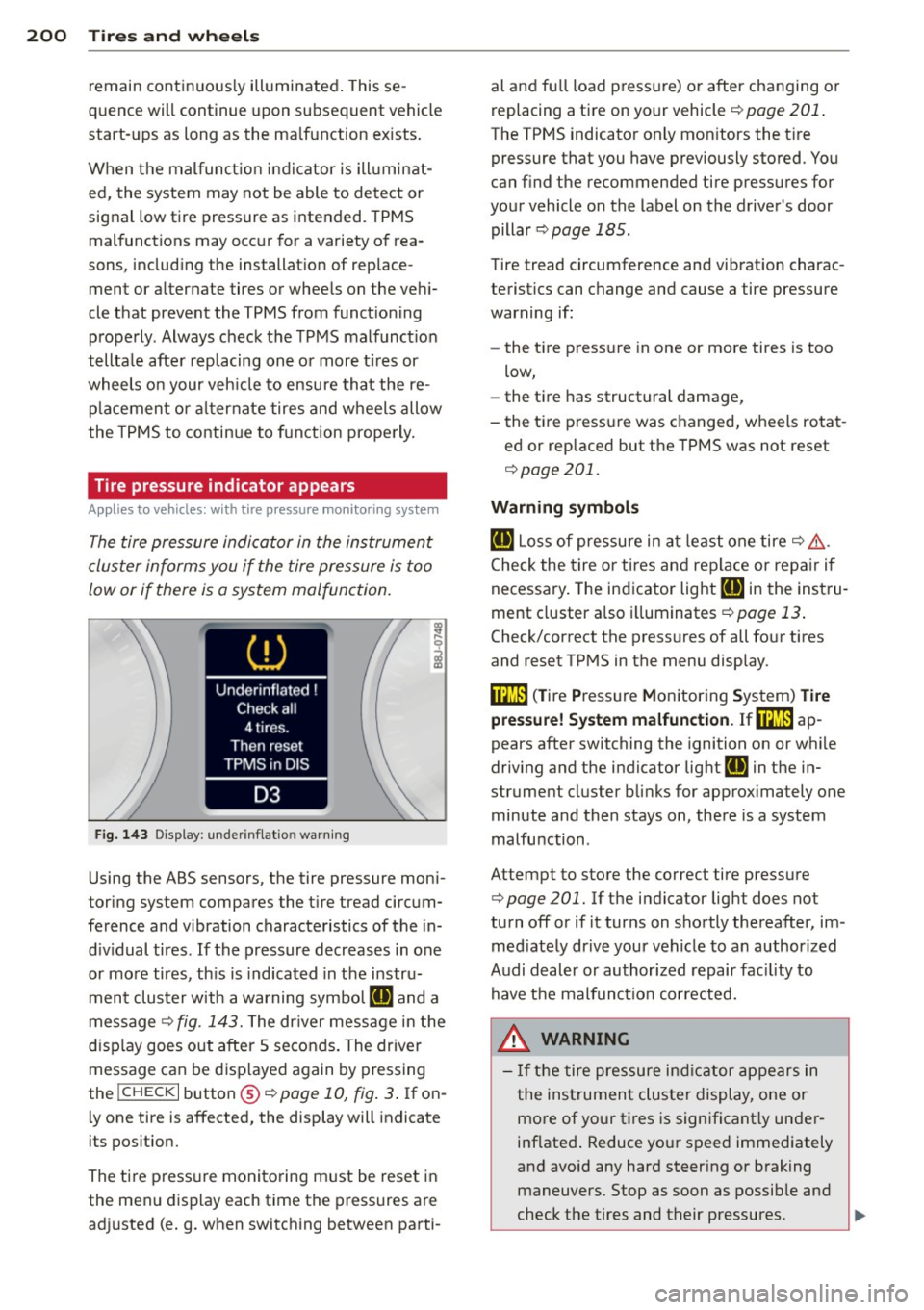
200 Tires and wheels
remain continuo usly illuminated . This se
quence will continue upon subsequent vehicle
start-ups as long as the ma lfunction ex ists.
When the malfunction indicator is illuminat
ed, the system may not be able to detect or
signal low tire pressure as intended. TPMS
malfunctions may occur for a variety of rea
sons, including the installation of replace ment or alternate tires or wheels on the vehi
cle that prevent the TPMS from functioning properly . Always check the TPMS malfunction
tellta le after replacing one or more t ires or
wheels on your veh icle to ensure that the re
placement or alternate tires and wheels allow
the TPMS to continue to function properly.
Tire pressure indicator appears
Applies to vehicles: with tire pressure monitoring system
The tire pressure indicator in the instrument
cluster informs you if the tire pressure is too
low or if there is a system malfunction.
F ig. 143 Display : underi nflat io n warn ing
Using the ABS sensors, the tire pressure moni
toring sys tem compares the t ire tread circum
ference and vibration characteristics of the in
d iv idual tires . If the pressure decreases in one
or more tires, th is is indicated in the instru
ment clus ter with a warning symbo l
ail and a
message<>
fig. 143. The dr iver message in the
display goes out after 5 seconds . The driver
message can be displayed again by pressing
the
! CHECK I button @¢ page 10, fig . 3 . If on
l y one tire is affected, the display will indicate
its pos ition.
The tire press ure monitoring m ust be reset in
the menu display each time the pressures are
ad justed (e.g. when switching between parti- al and fu
ll load pressure) or after changing or
replacing a tire on your vehicle<>
page 201.
The TPMS indicator only mon itors the t ire
pressure that you have previously stored . You
can find the recommended tire pressures for
your vehicle on the label on the driver's door
pillar
¢ page 185.
Tire tread circumference and vibration charac
teristics can change and cause a tire pressure
warning if:
- the t ire pressure in one or more tires is too
low,
- the tire has structural damage,
- the tire pressure was changed, wheels rotat -
ed or replaced but the TPMS was not reset
¢ page 201.
Warning symbols
ail Loss of pressure in at least one tire¢& .
Check the tire or tires and replace or repa ir if
necessary . The indicator light
HE in the instru
ment cluster also illuminates
<>page 13.
Check/correct the pressures of all four tires
and reset TPMS in the menu display .
ffim (T ire Pressure Monitoring System) Tire
pressure! System malfunction. Ifffim
ap
pears after switching the ignition on or while
driv ing and the indicator lig ht
HE in the in
strument cluster blinks for approx ima tely one
minute and then stays on, there is a system
malfunction .
At tempt to store the correct tire pressure
¢ page 201. Ifthe indicator light does not
turn
off or if it turns on shortly thereafter, im
med iate ly drive your vehicle to an author ized
Audi dealer or author ized repair facility to
have the malfunction corrected.
_&. WARNING
-
- If the tire pressure indicat or appears in
the instrument cluster display, one or
more of your tires is significant ly under
inflated . Reduce your speed immediately
and avoid any hard steer ing or braking
maneuvers. Stop as soon as possible and
check the tires and their pressures.
IJJ,,
Page 203 of 244
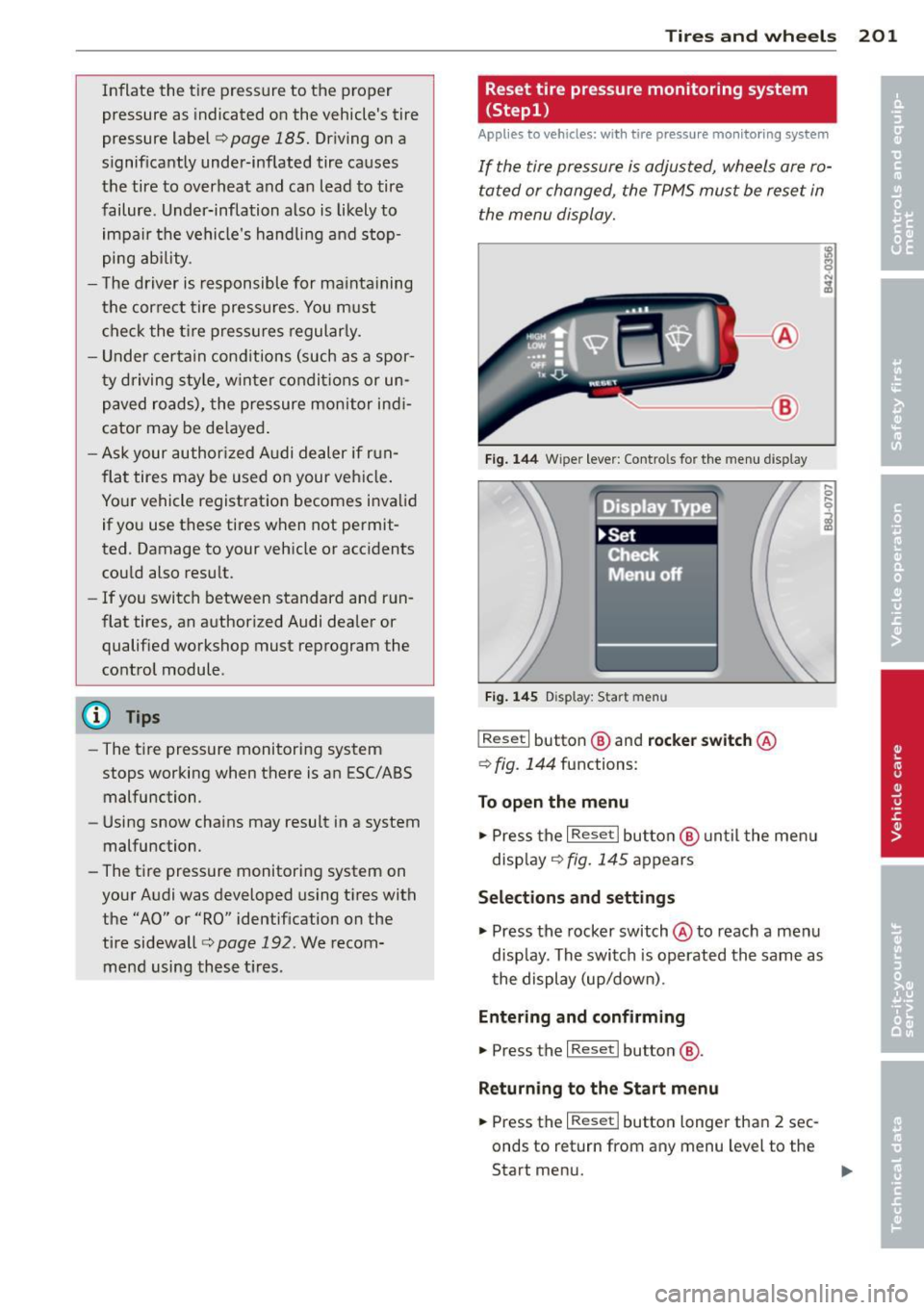
Inflate the tire pressure to the proper
pressure as indicated on the vehicle's tire
pressure label¢
page 185. Driving on a
significantly under-inflated tire causes
the tire to overheat and can lead to tire
failure . Under-inflation also is likely to
impair the vehicle's handling and stop
ping ability.
- The driver is responsible for mainta ining
the correct tire pressures. You must
check the tire pressures regularly.
- Under certain conditions (such as a spor
ty driving style, wint er conditions or un
paved roads), the pressure monitor indi
cator may be delayed .
- Ask your authorized Audi dealer if run
flat tires may be used on your vehicle.
Your vehicle registration becomes invalid if you use these tires when not permit
ted. Damage to your vehicle or accidents
could also result.
- If you switch between standard and run
flat tires, an authorized Audi dealer or
qualified workshop must reprogram the
control module .
@ Tips
-The tire pressure monitoring system
stops working when there is an ESC/ABS
malfunction.
- Using snow chains may result in a system
malfunction.
- The tire pressure monitoring system on
your Audi was developed using tires with the "AO" or "RO" identification on the
tire sidewall¢
page 192. We recom
mend using these tires.
Tires and wheels 201
Reset tire pressure monitoring system
(Stepl)
Appl ies to vehicles: wi th tire p ress ure mo nito ring system
If the tire pressure is adjusted, wheels ore ro
tated or changed, the TPMS must be reset in
the menu display.
--- ®
Fig. 144 Wiper lever : Controls for the menu display
Fig. 145 Display: Start menu
I Reset I button @ and rocker switch @
¢
fig. 144 functions:
To open the menu
.,. Press the I Reset I button @ until the menu
disp lay
9 fig. 145 appears
Selections and settings
.,. Press the rocker switch@ to reach a menu
disp lay. The switch is operated the same as
the display (up/down) .
Entering and confirming
.,. Press the I Reset I button @.
Returning to the Start menu
.,. Press the I Reset I button longer than 2 sec
onds to return from any menu level to the
Start menu. "'
Page 204 of 244
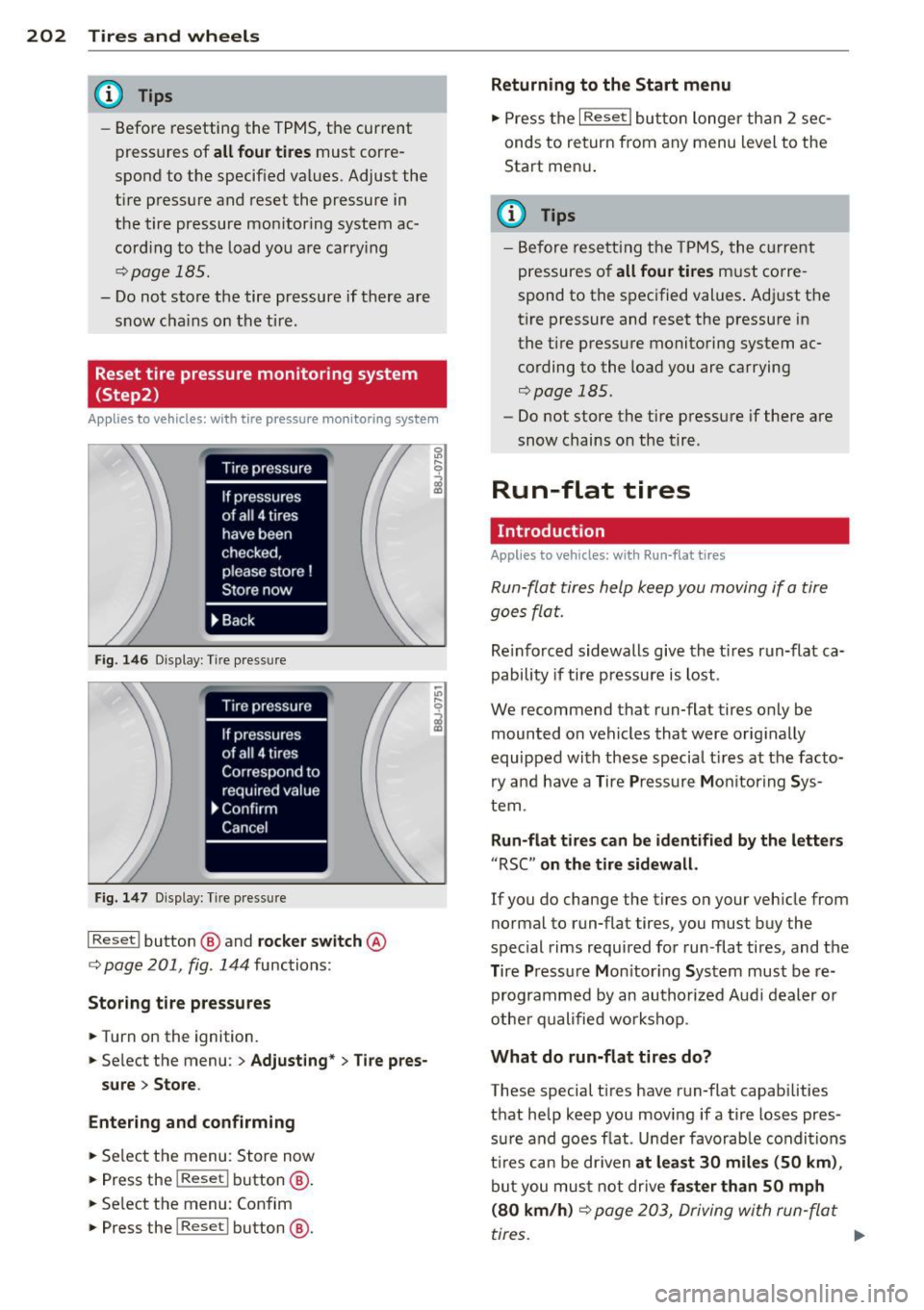
202 Tires and wheels
@ Tips
-Before resetting the TPMS, the current
pressures of
all four tires must corre
spond to the specif ied values. Adjust the
tire pressure and reset the pressure in
the tire pressure mon itor ing system ac
cord ing to the load you are carry ing
¢page 185.
- Do not store the tire pressure if there are
snow chains on the tire.
Reset tire pressure monitoring system
(Step2)
Ap plies to vehicles: with tire pressure mo nit oring sys te m
F ig. 146 Display: Tire pressure
Fig. 147 Display: Tire pres sure
I Reset I button @ and rocker switch @
c::, page 201, fig . 144 functions:
Storing tire pres sures
.. Turn on the ignition.
.. Se lect the menu :
> Adjust ing * > Tire pres
sure > Store.
Entering and confirming
.. Select the menu: Store now
.. Press the
I Reset ! button @.
.. Se lect the menu : Confim
.. Press the
I Reset ! button @.
Returning to the Start menu
.. Press the I Reset I button longer than 2 sec
onds to return from any menu level to the
Start men u.
(D Tips
-Before resetting the TPMS, the current
pressures o f
all four tires must corre
spond to the specified values . Adjust the
tire pressure and reset the pressure in
the tire pressure monitoring system ac
cording to the load you are carrying
c::, page 185.
-Do not store the tire pressure if there are
snow chains on the tire .
Run-flat tires
Introduction
Applies to vehicl es: wi th Run-fla t tires
Run-flat tires help keep you moving if a tire
goes flat.
Re inforced sidewalls give the ti res run-flat ca
pability if tire pressure is lost .
We recommend that run-flat tires only be
mounted on vehicles that were originally
equipped with these special t ires at the facto
ry and have a Tire Pressure Monitoring Sys
tem.
Run-flat tires can be identified by the letters
"RSC " on the tire sidewall.
If you do change the tires on your veh icle from
normal to run-flat tires., you must buy the
special rims required for run-flat tires, and the
T ire Pressu re M on itor ing System must be re
programmed by an authorized Audi dealer or
other qualified workshop .
What do run-flat tires do?
These special t ires have run-flat capabilities
that help keep you moving if a tire loses pres
su re and goes f lat . Under favorab le condit ions
t ir es can be dr iven
at least 30 miles (50 km) ,
but you must not drive faster than 50 mph
(80 km/h)
c::, page 203, Driving with run-flat
tires .
IJI>
Page 205 of 244
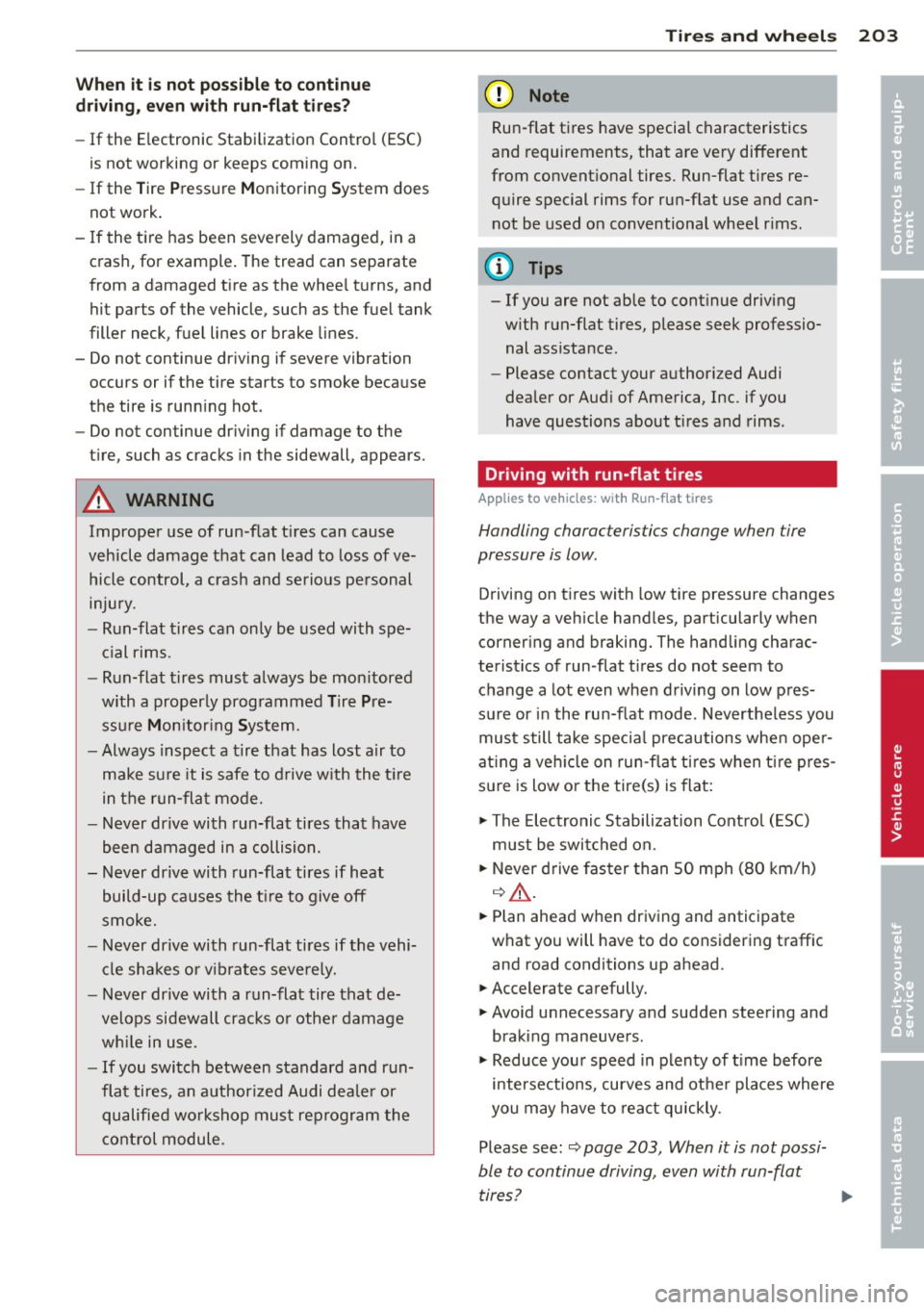
When it i s not po ssibl e to co ntinu e
d riv ing, even with run-fl at ti res?
-If the E lectronic Stabilization Control (ESC)
is not working or keeps coming on.
- If the Tire P ressure Monitoring System does
not work .
- If the tire has been severely damaged, in a
crash, for example. The tread can separate
from a damaged tire as the whee l turns, and
hit parts of the vehicle, such as the fuel tank
filler neck, fuel lines or brake lines.
- Do not continue dr iving if severe vibration
occurs or if the tire starts to smoke because
the tire is runn ing hot .
- Do not continue driving if damage to the
tire, such as cracks in the sidewall, appears.
A WARNING
Improper use of run-flat t ires can cause
vehicle damage that can lead to loss of ve
hicle control, a crash and serious personal
injury.
- Run-flat tires can only be used with spe
c ial rims.
- Run-flat tires must always be mon itored
with a properly programmed Tire Pre
ss ure Mon itor ing System.
- Always inspect a tire that has lost air to
make su re it is safe to drive w ith the t ire
in the run-flat mode.
- Never drive with run-flat tires that have
been damaged in a collision.
- Never drive with run-flat tires if heat
build-up causes the t ire to give off
smoke.
- Never drive with run-flat tires if the vehi
cle shakes or v ibrates severely.
- Never drive with a run-flat tire that de
velops sidewall cracks or other damage
wh ile in use .
- If you switch between standard and run
flat tires, an author ized Audi dealer or
qualified wo rkshop must reprogram the
control module.
Tire s an d wheel s 203
@ Note
Run-f lat ti res have special characteristics
and requirements, that are very different
from convent ional tires. Run-flat tires re
quire special rims for run-flat use and can
not be used on conventional whee l rims .
(D Tips
- If you are not able to cont inue driving
w ith run-flat tires, please seek professio
nal ass istance.
- Please contact your authorized Audi
dealer or Aud i of America, Inc . if you
have questions about t ires and rims.
Driving with run-flat tires
Applies to veh icles: w it h Run -flat t ires
Handling characteristics change when tire
pressure is low.
Driving on tires with low tire pressure changes
the way a veh icle handles, particularly when
corner ing and braking. The handling charac
teristics of run -flat tires do not seem to
change a lot even when driving on low pres
sure or in the run-flat mode . Nevertheless you
must still take specia l precautions whe n oper
at ing a veh icle on run-flat tires when t ire pres
s u re is low o r the tire(s) is flat:
" The Electronic Stabilization Contro l (E SC)
must be switched on.
" Never drive fas ter than 50 mph (80 km/h)
q .&_ .
"Plan ahead when driving and anticipate
what you will have to do considering traffic
and road conditions up ahead.
" Accelerate carefully.
" Avo id unnecessary and sudden steering and
braking maneuvers.
" Reduce your speed in plenty of t ime before
intersections, curves and other places where
you may have to react quickly .
Please see:
q page 203, When it is not possi
ble to continue driving, even with run-flat tires?
•
•
...
Page 206 of 244
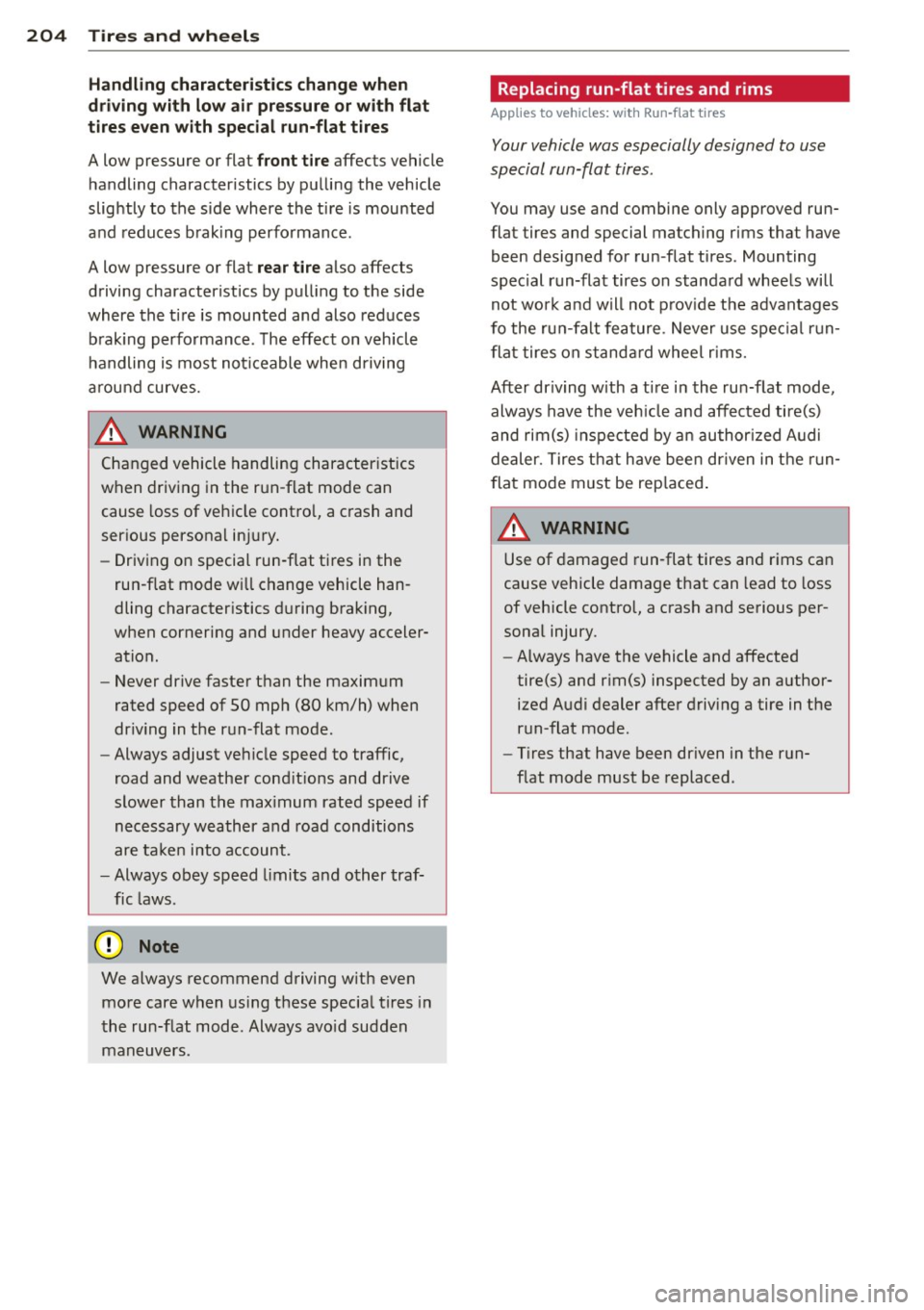
204 Tires and wheels
Handling characteristics change when
dr iving with low air pressure or with flat
tires even with special run-flat tires
A low pressure or flat front tire affects vehicle
handling characteristics by pulling the vehicle
slightly to the side where the tire is mounted
and reduces braking performance.
A low pressure or flat
rear tire also affects
driving characteristics by pul ling to the side
where the tire is mounted and also reduces
brak ing performance. The effect on vehicle
handling is most not iceable when driving
around curves.
& WARNING
Changed vehicle handling characteristics
when driving in the run -flat mode can
cause loss of vehicle contro l, a c rash and
serious personal in jury.
- Driving on special run-flat tires in the
run-flat mode will change vehicle han
dling characteristics during braking,
when cornering and under heavy acceler
ation .
- Never drive faster than the maximum
rated speed of 50 mph (80 km/h) when
dr iv ing in the run-flat mode .
- Always adjust vehicle speed to traffic,
road and weather cond itions and drive
slower than the max imum rated speed if
necessary weather and road conditions
are taken into account.
- Always obey speed limits and other traf
fic laws.
(D Note
We a lways recommend driving w ith even
more care when using these specia l tires in
the run-flat mode. Always avo id sudden
maneuvers.
Replacing run-flat tires and rims
Applies to veh icles: w it h Run -flat tires
Your vehicle was especially designed to use
special run-flat tires .
You may use and combine only approved run
flat tires and special matching rims that have
been designed for run -flat tires . Mounting
special run-flat tires on standard whee ls will
not work and will not provide the advantages
fo the run-falt feature. Never use special run
flat tires on standa rd whee l rims.
After dr iving w ith a t ire in the run-flat mode,
always have the veh icle and affected tire(s)
and rim(s) inspected by an author ized Audi
dealer. Tires that have been dr iven in the run
flat mode must be rep laced .
& WARNING
=
Use of damaged run-flat tires and rims can
cause vehicle damage that can lead to loss
of vehicle control, a crash and serious per
sonal injury.
- Always have the vehicle and affected
tire(s) and r im(s) inspected by an author
ized Audi dealer after driving a tire in the
run-flat mode.
- Tir es that have been dr iven in the run
flat mode must be replaced.
Page 207 of 244
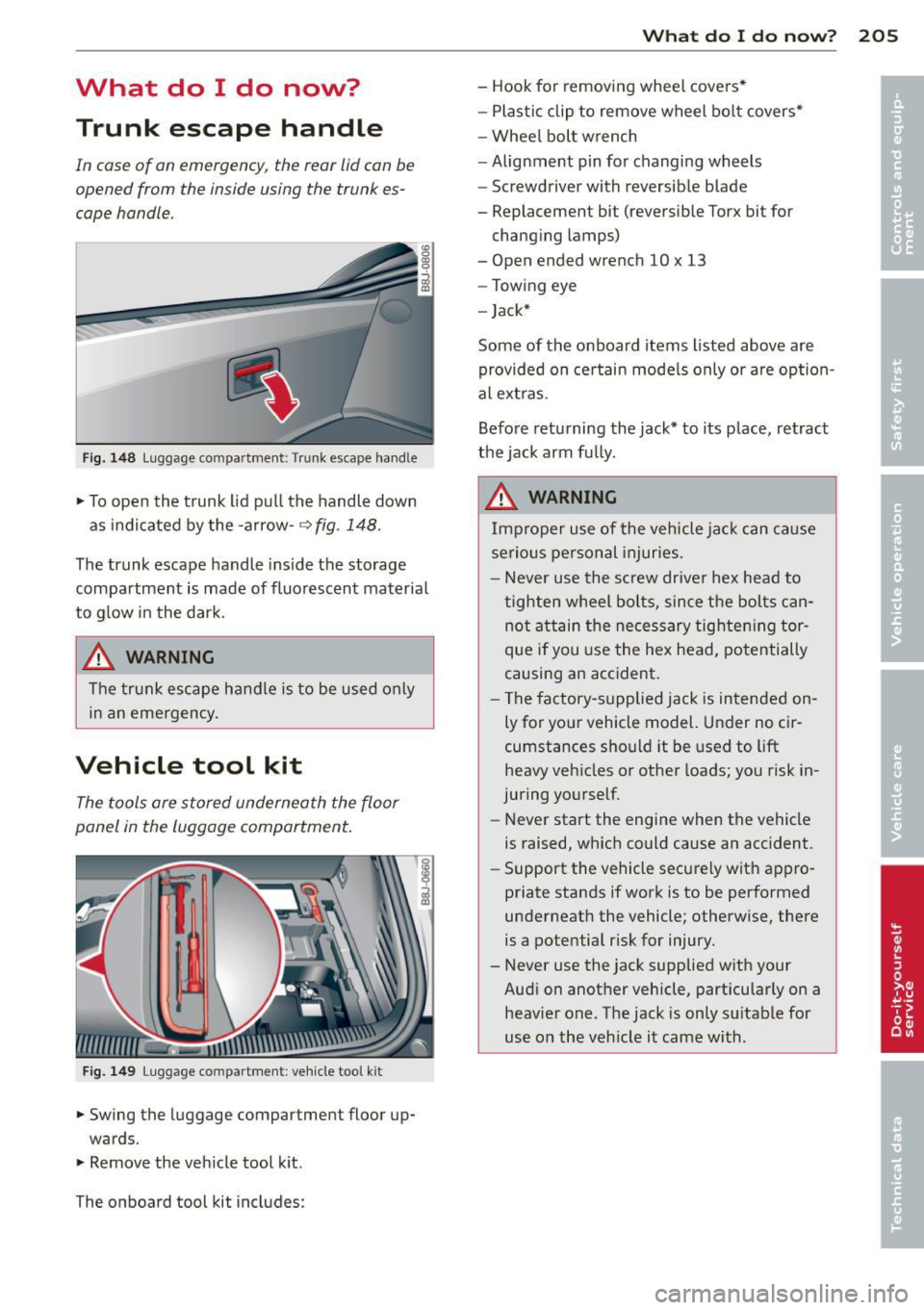
What do I do now? Trunk escape handle
In case of an emergency, the rear lid can be
opened from the inside using the trunk es
cape handle .
Fig. 148 Luggage compa rtment: Tr unk escape handle
"' To open the trunk lid pu ll the handle down
as indicated by the -arrow-~
fig. 148.
The trunk escape handle inside the storage
compartment is made of fluorescent materia l
to g low in the dark.
& WARNING
The trunk escape handle is to be used only
in an emergency .
Vehicle tool kit
The tools ore stored underneath the floor
panel in the luggage compartment.
F ig. 1 49 Luggage co mpa rt ment : veh icle tool ki t
"'Swing the luggage compartment floor up
wards.
"' Remove the vehicle tool k it.
The onboard tool kit includes:
What do I d o now ? 205
- Hook for removing wheel covers*
- Plastic clip to remove wheel bo lt covers*
- Wheel bolt w rench
- Alignment pin for changing wheels
- Screwdriver with reversible blade
- Replacement bit (reversible Torx bit for changing lamps)
- Open ended wrench 10 x 13
- Towing eye
- Jack*
Some of the on board items listed above are
provided on ce rtain mode ls only or are option
al ext ras.
Before returning the jack* to its place, retract
the jack arm fu lly.
& WARNING
Improper use of the vehicle jack can cause
serious pe rsonal injuries .
- Never use the screw drive r hex head to
tighten wheel bo lts, since the bolts can
not attain the necessary tighte ning tor
que if you use the hex head, potentially
causing an accident.
- The factory-supplied jack is intended on
ly for yo ur vehicle model. Under no ci r
cumstances should it be used to lift
heavy veh icles or other loads; you risk in
juring yourself .
- Never start the engine when the vehicle
is raised, wh ich could cause an accident.
- Support the vehicle securely with appro
priate stands if work is to be performed
underneath the vehicle; otherwise, there
is a potential risk for injury.
- Never use the jack supplied with your Audi on another vehicle, particularly on a heav ier one . The jack is only suitable for
use on the veh icle it came with .
Page 208 of 244
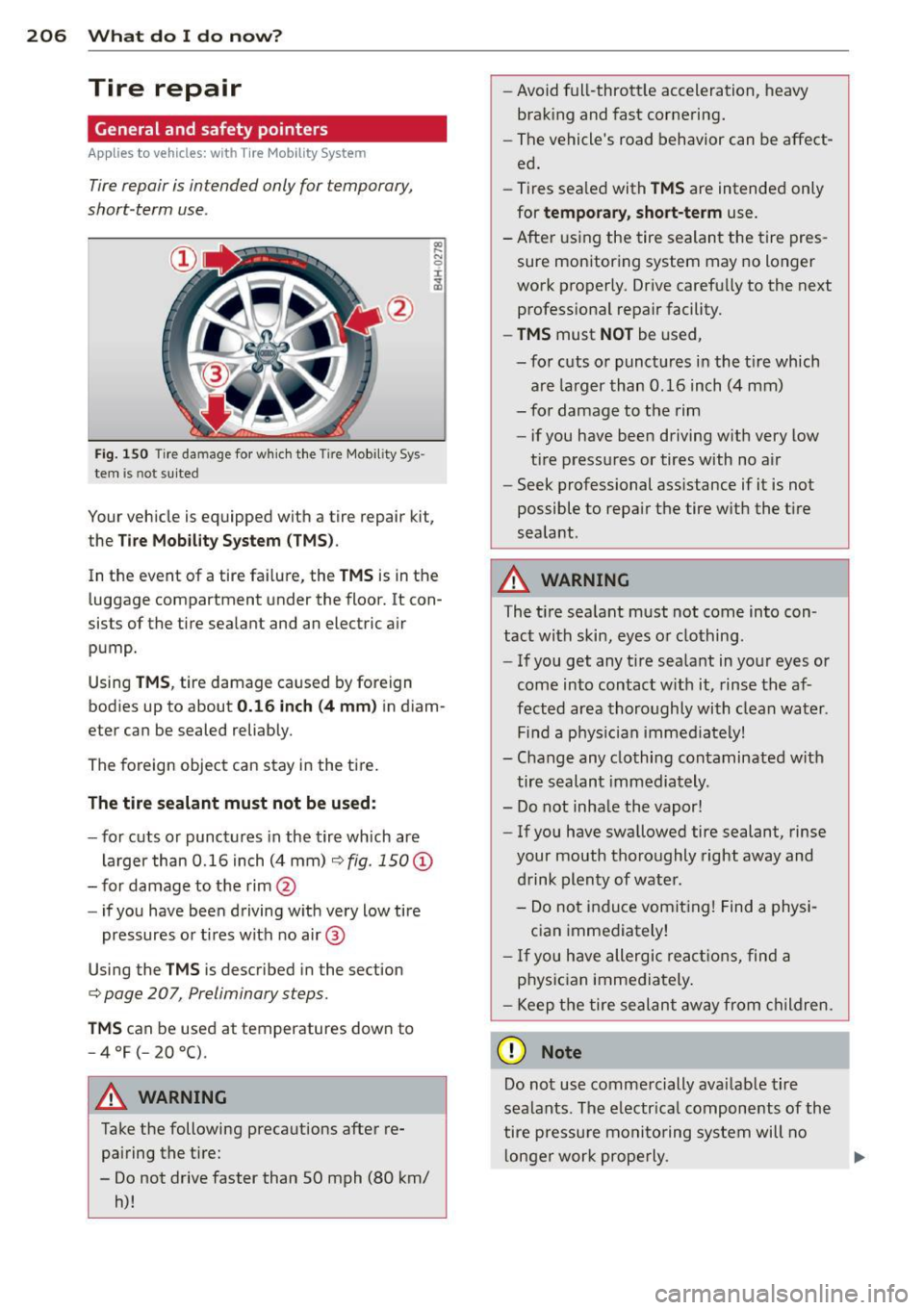
206 What do I do now?
Tire repair
General and safety pointers
Applies to vehicles: with Tire Mobility System
Tire repair is intended only for temporary,
short -term use .
Fig. 150 Tire da mage for wh ich the Tire Mob ility Sys
tem is not suited
Your vehicle is equipped with a tire repair kit,
the
Tire Mobil ity System (TMS ).
In the event of a tire fa ilure, the TMS is in the
luggage compartment under the floor. It con
sists of the tire sealant and an electric air
pump.
Using
TMS , tire damage caused by foreign
bodies up to about
0.16 inch (4 mm) in diam
eter can be sealed reliably.
The foreign object can stay in the tire.
The tire sealant must not be used :
-for cuts or punctures in the tire which are
larger than 0.16 inch (4 mm)
r=::> fig. 150 @
-for damage to the rim@
- if you have been driving with very low tire
pressures or t ires with no air®
Using the
TMS is described in the section
r=::> page 207, Preliminary steps.
TMS can be used at temperatures down to
- 4 °F (- 20 °() .
.&_ WARNING
Take the following preca utions after re
pairing the tire:
-
- Do not drive faster than SO mph (80 km/
h)! -
Avoid full-throttle acceleration , heavy
braking and fast cornering.
- The vehicle's road behavior can be affect
ed.
- Tires sea led with
TMS are intended only
for
temporary, short-term use.
-After using the tire sealant the tire pres
sure monitoring system may no longer
work properly. Drive carefully to the next
professional repair facility.
- TMS must NOT be used,
- for cuts or punctures in the t ire which
are larger than 0.16 inch (4 mm)
- for damage to the rim
- if you have been driving with very low
tire pressures or tires with no air
- Seek professional assistance if it is not
possible to repair the tire with the tire
sealant.
.&_ WARNING
The t ire sea lant must not come into con
tact with skin, eyes or clothing.
- If you get any ti re sealant in your eyes or
come into contact w ith it, rinse the af
fected area thoroughly with clean water .
Find a phys ician immediately!
- Change any clothing contaminated with
tire sealant immediately .
- Do not inhale the vapor!
- If you have swallowed tire sealant, rinse
your mouth thoroughly right away and
drink plenty of water.
- Do not induce vomiting! Find a physi
cian immediately!
- If you have allergic reactions, find a
physician immediately .
- Keep the tire sealant away from children.
(D Note
Do not use commercially available tire
sealants . The e lectr ica l components of the
tire pressure monitoring system will no
longer work properly.
Page 209 of 244
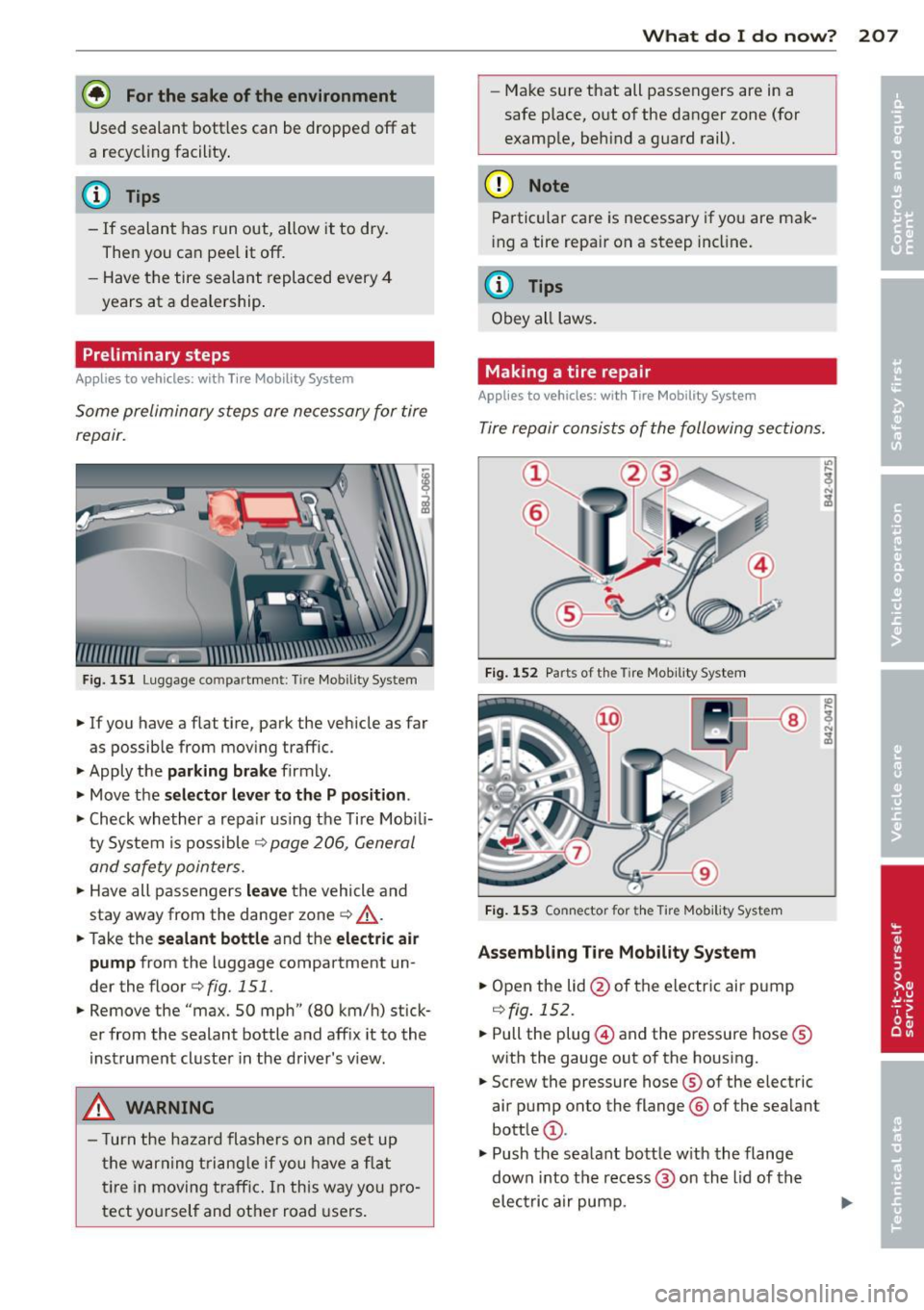
@ For the sake of the environment
Used sealant bottles can be dropped off at
a recycling facility .
@ Tips
-If sealant has run out, allow it to dry.
Then you can peel it off.
- Have the tire sealant replaced every 4
years at a dealership .
Preliminary steps
Applies to vehicles: with Tire Mobil ity System
Some preliminary steps are necessary for tire
repair.
Fig. 151 Luggage co mpa rt ment : Tir e Mobil ity System
1> Jf you have a flat tire, park the veh icle as far
as possible from mov ing traffic .
.,. Apply the
parking brak e firmly .
.,. Move the
se le ctor l ever to the P po sit ion .
.,. Check whether a repa ir using the Tire Mob ili
ty System is possible ¢
page 206, General
and safety poin ters .
.,. Have all passengers leave the vehicle and
stay away from the danger zone ¢
A.
.,. Take the se alant bottle and the ele ctri c air
pump
from the luggage compartment un
der the floor¢
fig. 15 l .
.,. Remove the "max. 50 mph" (80 km/h) stick
er from the sealant bottle and aff ix it to the
inst rument cluste r in the driver's v iew .
..&, WARNING
-Turn the ha zard flashers on and set up
th e war ning t ria ng le if you have a fla t
t ire in moving t raff ic. In this way you p ro
tect yo urself and other road users .
-
What do I do now ? 207
-Make sure that all passengers are in a
safe place, out of the danger zone (for
example, behind a guard rail).
(D Note
Particular care is necessary if you are mak
ing a tire repair on a steep incline.
(D Tips
Obey all laws.
Making a tire repair
Applies to vehicles : wit h Tire Mob ility System
Tire repair consists of the following sec tion s.
Fi g. 1 52 Parts of t he T ire Mobility System
Fi g. 1 53 Connector for th e Tire Mob ility System
Assembling Ti re Mobility System
.,. Open the lid @of the electr ic air p ump
¢ fig. 152 .
.,. Pull the plug@) and the pressure hose®
w ith the gauge out of the housing .
.,. Screw the pressure hose® of the e lectric
air pump onto the flange ® of the sealant
bott le @ .
.,. Push the sealant bott le w ith the flange
down into the recess @ on th e lid of th e
elec tric air pump.
IJ,-
Page 210 of 244

208 What do I do now?
• Remove the dust cap from the valve of the
defective tire.
• Screw the hose@) onto the valve
(J)
¢fig . 153.
• Insert the plug@¢ fig. 152 into the socket
for the cigarette lighter.
• Switch on the ignition .
Inflating tire
• Move the switch@¢ fig. 153 on the e lec
tric air pump
l ) to position I. After 5 mi
nutes, tire pressure must have reached at
least 1.8 bar .
• Switch the electric air pump off -switch in
pos it ion
0 . If the requ ired tire pressure of at
least 1.8 bar has not been reached, follow
the instructions in the section
Re-inflating
tire.
Re -inflating tire
• Remove the hose from the valve and pull the
plug out of the socket.
• Drive the vehicle slow ly 10 meters backward
or forward. This helps to distribute the seal
ant better .
• Remove the empty inflation bott le and
screw the hose®¢
fig. 152 from the elec
tric pump directly onto the valve.
• Insert the plug@¢
fig. 152 into the socket
for the cigarette lighter.
• Switch on the ignition .
• Move the switch @¢
fig. 153 on the e lec
t ric air pump
l) to posit ion I. After 5 mi
nutes, tire pressure must have reached at
least 1.8 bar.
• Switch the electric air pump off -switch in
position
0. If the required tire pressure of at
l east 1.8 bar has not been reached, it is not
poss ible to make a repair with the tire seal
ant. Seek professional ass istance.
Disassembling Tire Mobility System
• Remove the hose from the valve and pull the
plug out of the socket.
• Screw the dust cap onto the va lve.
1l The electric air p ump sho uld never ru n fo r long er than
6 min utes.
• Place the empty sea lant bott le back in the
original packaging and clip it in place under
the floor so that no t ire sea lant can run out
into the veh icle.
• Place the electric air pump in the luggage
compartment for the t ime being .
• Start driv ing right away so that the sealant
is distributed in the tire.
_&. WARNING
- Follow the manufacturer's safety instruc
tions on the decal for the air pump and
the sealan t bottle.
- If a tire pressure of 1.8 bar cannot be
achieved after pumping for 5 minutes,
the tire is too severe ly damaged. Do not
continue to drive.
- Seek professional assistance if it is not
possible to repair the tire with the tire
sealant.
(D Tips
- Do not operate the electric air pump for
more than 6 minutes without stopping,
otherwise it can overheat . When the air
pump has cooled down, you can continue
to use it.
- If sea lant has escaped, allow it to dry,
then you can pee l it off.
Final check
App lies to vehicles: wit h Tire Mobility System
After driving for a short distance, tire
pressure must be checked
• After driving for about 10 minutes, stop and
check the tire pressure .
• If tire pressure is still at least 1.3 bar, in
flate the tire to specified pressure (see driv
ers side B-pillar), drive to the next repa ir
shop and have the tire and the sealant bot
tle replaced.
• If tire pressure is less than 1.3 bar, the tire
is too severely damaged. Do not continue to
drive . Seek professional assistance. .,.